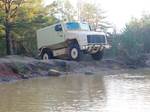Hybrid Enhanced Combat Helmet enters final testing phase
The U.S. Army and Marine Corps are conducting final validation testing of the U.S. military’s next-generation — and radically new — thermoplastic composite Enhanced Combat Helmet (ECH).
The U.S. Army and Marine Corps are conducting final validation testing of the U.S. military’s next-generation — and radically new — combat helmet at the Army Research Laboratory’s Aberdeen Proving Ground in Maryland. Testing on the Enhanced Combat Helmet (ECH), is expected to last 6 to 12 months. The previous-generation Advanced Combat Helmet (ACH) — currently in use by most U.S. combat troops — is made primarily of Kevlar and phenolic resin. The ECH will be the first to incorporate thermoplastic resin in its construction. Military sources tell HPC that the ECH comprises a carbon-fiber inner cage overmolded with a preform made from Spectra ultrahigh-molecular-weight polyethylene (UHMWPE), supplied by helmet development partner Honeywell Advanced Fibers and Composites (Colonial Heights, Va.).
“The ECH involves a change in materials, a change in the manufacturing process and a change in the specifications,” says Honeywell’s armor industry technical leader Lori Wagner. While the UHMWPE outer hemisphere imparts the energy-absorbing antiballistic behavior, the carbon inner cage is designed to resist deformation, offering better local-impact protection for the wearer. The design reportedly results in a 10 percent improvement in ballistic protection while reducing helmet weight.
The military is expected to issue production contracts to several manufacturers. The helmet will be made using an out-of-autoclave, automated compression-style press. Automation is expected to reduce the cost of making the ECH by 10 to 15 percent compared to the ACH.
Related Content
-
Plataine unveils AI-based autoclave scheduling optimization tool
The Autoclave Scheduler is designed to increase autoclave throughput, save operational costs and energy, and contribute to sustainable composite manufacturing.
-
Busch expands autoclave solutions
Busch announces its ability to address all autoclave, oven and associated composites manufacturing requirements following the acquisition of Vacuum Furnace Engineering.
-
Industrial composite autoclaves feature advanced control, turnkey options
CAMX 2024: Designed and built with safety and durability in mind, Akarmark delivers complete curing autoclave systems for a variety of applications.


